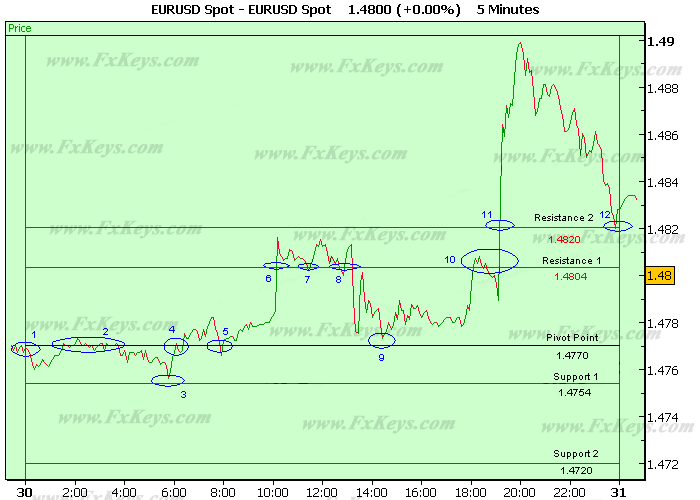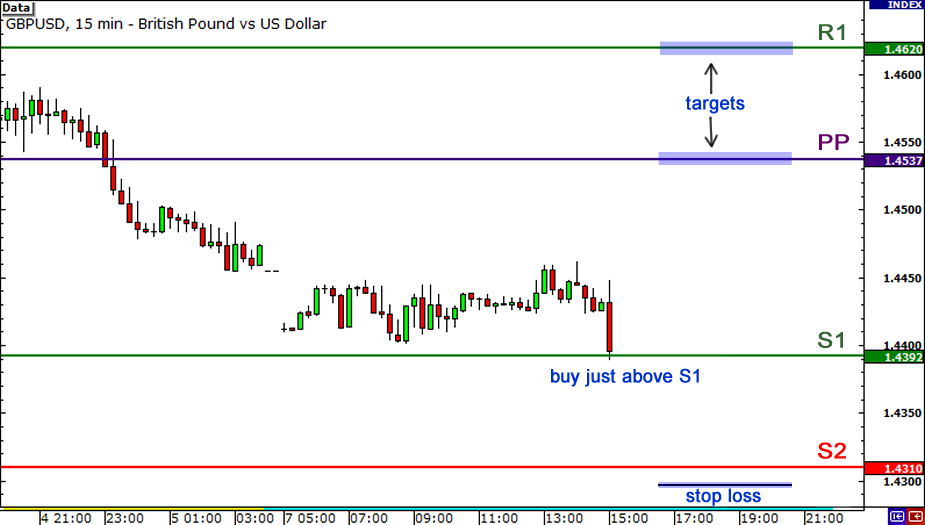How to Use Pivot Points in Forex Trading
Post on: 12 Март, 2016 No Comment

Technically Pure
FX markets trade technically purer than stock markets something which we are all very thankful for! By that I mean price action reacts much better to resistance and support levels on a chart much better than equity markets do. FX traders and dealers only have supply and demand to make their buy/sell decisions from. Its all based on price levels, which is reflected in the charts. FX markets react better than stocks when it comes to Fibonacci tools, pivot points, trendlines and prior resistance support levels, etc.
Click here to order your copy of The VXX Trend Following Strategy today and be one of the very first traders to utilize these unique strategies. This guidebook will make you a better, more powerful trader.
A lot of stock market price action is driven up, down or sideways by an endless procession of factors. Part of it is economic, part of it is fundamental to specific company, industry or sector. Another part of stock market action is pure emotion. Someone makes or sells a widget with perceived value higher than what turns out to be economic reality. Doesnt matter stock prices can remain pumped on pure emotion longer than rational people can comprehend.
Another part of stock market behavior is rampant program trading. I read somewhere this weekend that stock market program trading measured by percentage of volume is now at historical all-time highs. Black box computer robots making buy/sell decisions shove stock market price action every which way but loose. Good luck timing some of those price swings or turns when the big bots flip one another like scattered dominos.
Currency markets arent nearly like that. FX trade decisions are pretty much pure supply & demand, a commodity if you will. Now thats not to say they arent affected by economic news or events. Each currency is weighted on econ conditions for that specific pair versus any or all others in the marketplace. Price value of currencies is nothing more than a reflection of where that denominations economy ranks as weak or strong relative to others. There is no sentimental or emotional impact on a currency. No one buys the British Pound to unreasonable heights because they like the color scheme of the paper bills. No one sells the USD/CHF because that country has great skiing in the winter, therefore its a play to profit from guesswork of increased tourism. If the Swiss economy is weak or strong, itll be amply reflected in the CHF pairs accordingly.
Fair Value On The Floor
There are many ways to measure what fair value is for trading instruments. Volume studies like market profile or volume-weighted average price (vwap) are not applicable in spot forex markets because there is no centralized volume measurement. We could say that the old floor traders pivot values are one way to measure fair-value pricing in currency markets, i.e. a spot on the chart where neither buyers or sellers have firm control. Frequent tests of that level (or more aptly zone) gives a chance for traders to see which way prevails on the inevitable push away from there.
Like we said earlier, FX currency markets trade technically purer than stock markets being mercifully devoid of emotional baggage that gets attached to companies underlying stocks. No one cares to let alone physically can prop up or repress any major currency from trading higher or lower based on pure supply & demand which is one of many benefits to be grateful for in FX. Floor trader pivot levels are one chart tool which adds value to our chart. I personally ignore all the levels except for daily pivot-point itself actually have the others turned off so only the pivot is plotted.
Because the FX markets never sleep, its debatable where to define a start & stop for determining floor trader pivot levels. After looking at all manner of settings, I simply go with a midnight to midnight est measurement and leave it at that. Writing the chart software code to measure FX sessions from 5pm est to 5pm est or something similar is another choice. Others opt to align floor trader pivot session measures with the hours of trading for that specific symbol or pair, i.e. open of Englan markets for GBP pairs, open of Japanese markets for JPY pairs, etc. In my opinion those are probably equal choices for effectiveness but no better or worse than standard pivot settings for midnight to midnight stretch. Along the endless journey a market takes going from point A to point B or likewise B to A, price action pauses at numerous spots. Im sure we can find merit with just about any setting for daily pivot points probably several of them. Pick one and stick with it for consistency sake. Its more of an individual choice than anything else, in all reality.
Chart 1: GBP/USD 10-Minute Chart
Looking at a 10 min chart of the Pound/Dollar, we see where price action held on top of daily pivot point (black line) support for several hours before lifting into R1 (dashed green) and S2 (solid green) on its way to eventual swing highs. Price action then settled right back to the R2 which was prior resistance now turned support. Where it heads to next may be determined by which way it breaks from the R2 magnet of price measurement.
From low to high the GBP/USD covered roughly 200 pips or $2,000 per standard FX contract. Taking +50pip to +100pip trades out of that overall swing was possible by targeting moves between or away from the various pivot levels.
Chart 2: USD/JPY 10-Minute Chart
Opposite the GBP and EUR but in mirrored fashion, CHF pushed away from its daily pivot and plunged below S2 towards what was in all likelihood S3 level before consolidating on a turn back upwards. Again, taking entry signals right at the various levels or as price action moves away from them is a pure form of catching directional moves headed towards visible targets.

Chart 3: EUR/JPY 10-Minute Chart
As noted before, FX markets tend to test the daily pivot at least once per session before pushing away to fulfill supply & demand elsewhere. Using that measure in conjunction with your other varied chart tools is an additional edge for pending directional bias.
Chart 4: USD/CHF 10-min Chart
True to frequent form, in this example the USD = Swiss Franc paused in consolidation at its daily pivot point before continuing the trend trek upwards from there.
Summation
Floor trader pivots have stood the test of time for a reason: price action reacts to them. For sure theres a limit to what will fit on our chart before the scene of visual clarity becomes clutter. Ive always been an advocate of the less is more school for chart tools. That said, it pays to know where key price magnets are which help show the tipping points on our chart. Daily pivot points for currency/FX markets are one of several chart tools that add such value. Using them as a marker for points of attraction where price action is likely to trade and/or secondary spots for trade-entry decisions.
Austin Passamonte is a full-time professional trader who specializes in E-mini stock index futures and commodity markets. Mr. Passamontes trading approach uses proprietary chart patterns found on an intraday basis. Austin trades privately in the Finger Lakes region of New York. Click here to visit CoiledMarkets














